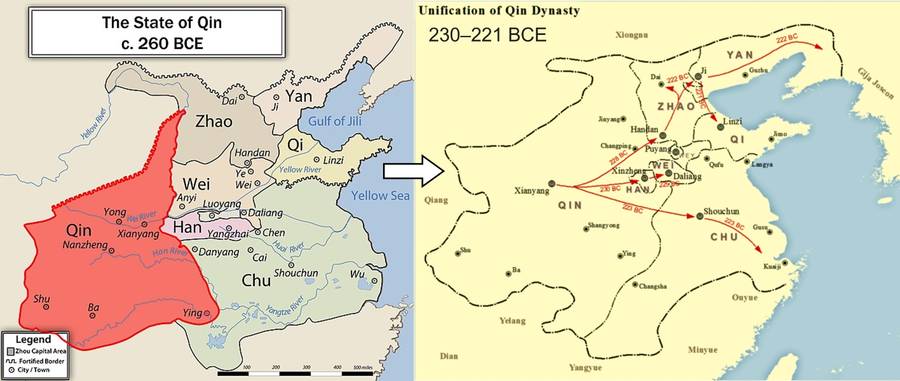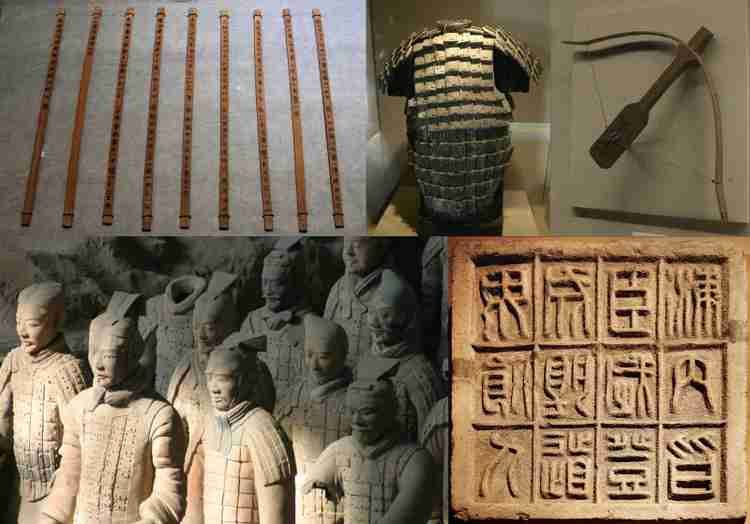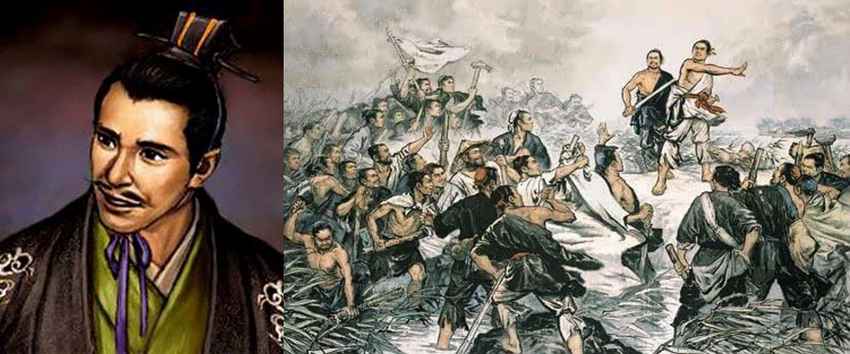Chinese Dynasty: Qin Dynasty (221 to 206 BCE)
The Qin Dynasty (秦, Qín) was a short but important period in Chinese history, lasting from 221 to 206 BCE. It was a time of significant political, economic, and cultural change, marked by the unification of China and the establishment of a highly centralized government under the rule of the emperor.
Origins and Establishment of the Qin Dynasty

Qin state and Qin Dynasty maps
The Qin Dynasty (221-206 BCE) was the first dynasty of Imperial China that united the separate states following the Warring States Period (战国, Zhàn Guó, 475-221 BCE), the era of near-constant warfare resulting from the decline of the Zhou Dynasty (1046-256 BCE).
The Qin Dynasty (秦朝) originated from the state of Qin (秦国), one of the many small feudal states into which China was divided between 770 and 221 BCE, that is, from the Spring and Autumn Period (春秋, Chūn Qiū, 770-476 BCE) till the end of the Warring States Period. Note that the majority of this time period is the Eastern Zhou Dynasty (东周, 770-256 BCE).
The origins of Qin can be traced back to the sixth year of King Xiao of Zhou (周孝王六年, 905 BCE) when Fei Zi (秦非子) was granted a fiefdom as a reward for his contribution to raising horses. He became the ruler of the settlement of Qin (秦邑), located in present-day northeast QingShui County (清水县) of Gansu (甘肃), and was given the title of Qin Ying (秦嬴).
Qin later became a vassal state of the Zhou Dynasty in 770 BCE after Duke Xiang of Qin (秦襄公) dispatched troops to escort King Ping of Zhou (周平王) to the east and established the Eastern Zhou Dynasty.
During the reign of Duke Xiao of Qin (秦孝公, 381-338 BCE) during the Warring States period, the Qin state implemented Shang Yang's reforms (商鞅变法) and gradually became the most powerful state. From 230 to 221 BCE, King Zheng of Qin (秦王嬴政, also known as Qin Shi Huang) defeated the other six states including Han, Zhao, Wei, Chu, Yan, and Qi (韩、赵、魏、楚、燕、齐), and established the first unified dynasty in Chinese history, the Qin Dynasty.
Reforms and Accomplishments

Left: an imaginary illustration of Qin Shi Huang. Right: a restoration model of Xianyang Palace.
After the establishment of the Qin Dynasty, King Zheng of Qin took parts from ancient legends, and called himself 始皇帝 (Shǐ Huáng Dì), meaning the first emperor, and that the throne will pass down for generations. This is why he is historically known as 秦始皇 (Qín Shǐ Huáng).
Qin Shi Huang was known for implementing a number of administrative and political reforms that helped him to centralize power and establish a strong, centralized government.
Despite being a short-lived dynasty that lasted only 15 years, the Qin Dynasty had a profound impact on China's history. The Qin Dynasty was responsible for many political, cultural, and intellectual achievements that helped shape China's future.

Important Qin Dynasty achievements
Standardization: One of the most significant reforms introduced by Qin Shi Huang was standardization. He standardized weights, measures, and currency, and created a uniform system of writing throughout the empire called small seal script (小篆, xiǎo zhuàn). This helped to promote communication and trade, as well as understanding among the people.
Centralization: Qin Shi Huang also established a strong centralized government. Working with his prime minister Li Si (李斯), he abolished the feudal system and replaced it with a bureaucracy that was directly answerable to him. This helped to eliminate corruption and ensure that the government was more efficient.
Legalism: Qin Shi Huang was a proponent of Legalism, a philosophy that stressed strict laws and harsh punishments. He implemented a standardized legal code throughout the empire and created a network of officials who were responsible for enforcing the law. Although the legal code included harsh punishments and strict penalties for lawbreakers that exacerbated the fall of the Qin Dynasty, this legal system was the basis for the law codes of later dynasties in China.
Military: The Qin Dynasty introduced game-changing innovations such as the crossbow and cavalry, and standardized weapons and military training across the empire's army. The Qin also centralized military command, allowing for the effective and efficient carrying out of orders. These reforms made the military and government thrive and their legacy continued to influence Chinese warfare for centuries to come.
Meritocratic Administration System: During the reign of Duke Mu of Qin (秦穆公, 659-621 BCE), the state of Qin started using officials based on their abilities rather than their social status. Such a meritocratic administration system continued during the Qin Dynasty. Prospective officials could come from a rural background and government positions were not restricted to the nobility.
Infrastructure: The Qin invested heavily in infrastructure projects. Many large-scale building projects were initiated including road networks and canals that connected different parts of the empire and made trade and commerce more efficient.
The Qin Dynasty began construction on what would become one of the most iconic structures in human history - The Great Wall of China, which was built to protect the empire from invasions by northern nomads. Although much of what we see today was built during later dynasties, it was during the Qin Dynasty that construction began.
The Qin Dynasty also created the Terracotta Army, a collection of life-size terracotta statues of warriors, chariots, and horses depicting the armies of Qin Shi Huang, which were buried with him, the first emperor of China, to protect him in the afterlife.
Overall, Qin Shi Huang's political reforms helped to establish a strong, centralized government that was capable of controlling a vast empire. Although some of his methods were harsh, they were effective in promoting stability and prosperity during his reign.
Criticisms
The Qin Dynasty, while having many achievements, at the same time it was also heavily criticized for its policies and practices, including harshness of laws and intolerance of criticism. Qin Shi Huang imposed punitive laws and widespread use of free and forced labor. The Qin Dynasty also heavily regulated commerce, particularly in terms of taxation.
Some of the main criticisms of the Qin Dynasty include:
Harsh Legalism: The Legalist philosophy of the Qin Dynasty emphasized strict laws and harsh punishments, which were often seen as oppressive and cruel.
Authoritarianism: The Qin Dynasty was characterized by a strong centralized government, which often acted in an authoritarian manner, suppressing dissent and enforcing conformity.
Brutal Suppression of Dissent: Qin Shi Huang was especially notorious for his brutal suppression of dissent, including the burning of books and the burying alive of scholars who opposed his policies (known as "burning of books and burying of scholars", 焚书坑儒).
Forced labor: The Qin Dynasty was known for its policy of forced labor, which was used to build massive infrastructure projects like canals and roads, palaces, Qin Shi Huang's mausoleum (where the Terracotta Army is located), as well as the Great Wall of China. Many laborers died in the construction process, and the practice was seen as a form of exploitation.
Commerce Policies: The dynasty imposed heavy taxes on merchants, established state monopolies on certain industries, and implemented strict regulations on commerce and trade, which could be cumbersome and bureaucratic. Merchants were also subject to strict regulations and licensing requirements, and if they were to go bankrupt, they would be incorporated into the state's hard labor.
While the Qin Dynasty achieved many notable accomplishments, its policies and practices were often criticized for their harshness and lack of concern for human rights. Consequently, this contributed to political instability and infighting and eventually led to the fall of the dynasty quickly after Qin Shi Huang's death.
Fall of the Qin Dynasty

Left: a portrait of Qin Er Shi. Right: an illustration of Chen Sheng Wu Guang's uprising.
Due to infighting and rebellion, after the death of Qin Shi Huang in 210 BCE, the dynasty collapsed not long after his son, Hu Hai (胡亥), or Qin Er Shi (秦二世, Qin the Second) took the throne.
In 209 BCE, a massive peasant rebellion broke out, led by Chen Sheng (陈胜) and Wu Guang (吴广). The rebellion was fueled by widespread dissatisfaction with the harsh policies and practices of the Qin Dynasty, including forced labor and heavy taxation. The rebellion quickly spread throughout the empire, and although it was eventually suppressed, it weakened the dynasty's power and legitimacy.
Since Qin Er Shi ascended the throne, he was seen as weak and ineffective, and his advisors and officials conspired against him. In 207 BCE, he was assassinated, which further destabilized the dynasty and contributed to the succession crisis.
In 206 BCE, the last Qin emperor, Zi Ying (子婴), who was only on the throne for 46 days, surrendered to the rebel leader Liu Bang (刘邦), who later established the Han Dynasty (汉, Hàn) in 202 BCE. Zi Ying was killed by Xiang Yu (项羽) about a month after his surrender.
Legacy of the Qin Dynasty

Despite its short-lived rule which lasted for only 15 years, the Qin Dynasty left a lasting impact on Chinese history. It was a time of significant political, economic, and cultural change, marked by the unification of China and the establishment of a highly centralized government.
The standardization of the Chinese language, weights, and measures, and the legal system established during the Qin Dynasty formed the basis for later dynasties in China.
The philosophy of Legalism, which was the basis of the Qin Dynasty's political system, had a profound impact on Chinese political thought and legal system.
The terracotta army, which was buried with Qin Shi Huang, is one of the greatest archaeological discoveries in China and a testament to the dynasty's military, as well as artistic and cultural achievements.
The Great Wall of China, built during the Qin Dynasty, remains one of the most iconic landmarks in China today and is a symbol of the country's strength and unity.
On the other hand, the Qin Dynasty is also remembered for its cruelty and oppression. Qin Shi Huang's harsh laws and punishments and his suppression of dissent led to widespread discontent and rebellion. The dynasty's collapse was a result of the people's dissatisfaction with the regime, and its legacy serves as a cautionary tale of the dangers of authoritarian rule.
The Qin Dynasty was a significant period in Chinese history, marked by the unification of China and the establishment of a highly centralized government. Qin Dynasty's achievements in politics, economics, and culture, as well as its legacy in Chinese philosophy and culture, have had a lasting impact on China and the world. However, the dynasty's cruelty and oppression serve as a warning against the dangers of authoritarian rule and the importance of preserving freedom and democracy